Related Research Articles

Ausia fenestrata is a curious Ediacaran period fossil represented by only one specimen 5 cm long from the Nama Group, a Vendian to Cambrian group of stratigraphic sequences deposited in the Nama foreland basin in central and southern Namibia. It has similarity to Burykhia from Ediacaran (Vendian) siliciclastic sediments exposed on the Syuzma River of Arkhangelsk Oblast, northwest Russia. This fossil is of the form of an elongate bag-like sandstone cast tapering to a cone on one end. The surface of the fossil is covered with oval depressions ("windows") regularly spaced over the surface in the manner of concentric/parallel rows. The taxonomic identity of Ausia is unresolved.
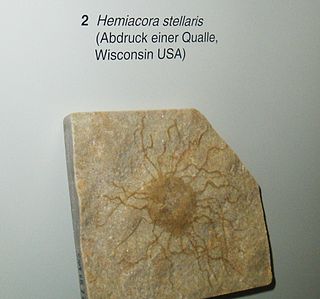
Hiemalora is a fossil of the Ediacaran biota, reaching around 3 cm in diameter, which superficially resembles a sea anemone. The genus has a sack-like body with faint radiating lines originally interpreted as tentacles, but discovery of a frond-like structure seemingly attached to some Heimalora has added weight to a competing interpretation: that it represents the holdfast of a larger organism.
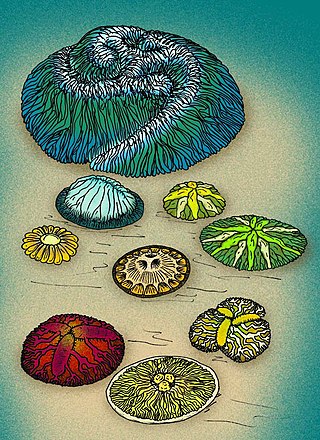
Trilobozoa is a phylum of extinct, sessile animals that were originally classified into the Cnidaria. The basic body plan of trilobozoans is often a tri-radial or radial sphere-shaped form with lobes radiating from its centre. Fossils of trilobozoans are restricted to marine strata of the Late Ediacaran period.
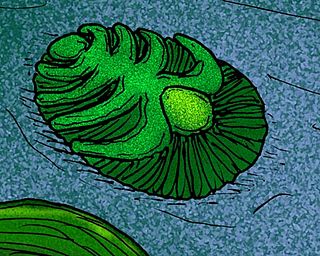
Praecambridium sigillum is an extinct organism that superficially resembles a segmented trilobite-like arthropod. It was originally described as being a trilobite-like arthropod, though the majority of experts now place it within the Proarticulata as a close relative of the much larger Yorgia. It is from the Late Ediacaran deposit of Ediacara Hills, Australia, about 555 million years ago. On average, P. sigillum had at least 5 pairs of segments, with each unit becoming progressively larger as they approach the cephalon-like head.
Anfesta stankovskii is a tri-radially symmetrical fossil animal that lived in the late Ediacaran (Vendian) seafloor. It is a member of the extinct group Trilobozoa.
Vaveliksia is an extinct genus of Ediacaran Sponge-like organism with a long, tubular-shaped body and a attachment disk similar to that of Petalonamids. The Vaveliksia genus contained two species, Vaveliksia velikanovi as well as Vaveliksia vana. The two species vary in appearance to one another, with V. velikanovi having a more tubular-shaped, sack-like morphology with a crown of wrinkles on top of one of its ends as well as possessing a much more disk-like holdfast with V. vana having an appearance more similar to that of a Poriferan, with V. vana having a much more dome-shaped holdfast and a capsule-like body with no crown of wrinkles unlike V. velikanovi.
Protechiurus edmondsi is a species of fossil animal from the Ediacaran Nama group of Namibia. It was initially interpreted as an echiurid worm. It has been placed as a "vendobiont", on the hypothesis that the Edicarian fauna represent a distinct phylum. It has also been suggested that it may be an ecdysozoan.

Arborea is a genus of Petalonamid that was originally considered as being synonymous with Charniodiscus. It consisted of a frond-like body 3–4 inches (7.6–10.2 cm) long that was attached to the substrate via a Holdfast that possessed many concentric rings on it. Species which were thought to have been within the genus Charniodiscus are now being interpreted as belonging to the genus Arborea with the latter of which being considered synonymous with Charniodiscus. A. arborea was first described from South Australia, and is the most abundant Petalonamid in the Flinders Ranges. The genus currently contains 5 known species with 3 of them originally being species of Charniodiscus; the species include A. arborea, A. denticulata, A. longa, A. oppositus and A. spinosa.
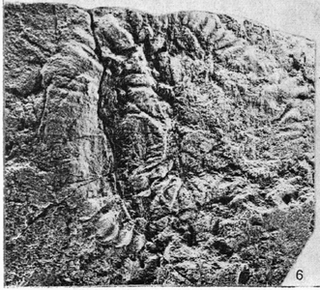
Veprina is a rare Ediacaran coelenterate cnidarian found on the Zimny coast of the White Sea, Russia and was first described by Mikhail Fedonkin in 1980.
Palaeoplatoda is a genus from the Ediacaran biota. It is a soft-bodied organism with a segmented body that resembles Dickinsonia, another Ediacaran organism.

The petalonamids (Petalonamae) are an extinct group of archaic animals typical of the Ediacaran biota, also called frondomorphs, dating from approximately 635 million years ago to 516 million years ago. They are benthic and motionless animals, that have the shape of leaves, fronds (frondomorphic), feathers or spindles and were initially considered algae, octocorals or sea pens. It is now believed that there are no living descendants of the group, which shares a probable relation to the Ediacaran animals known as Vendozoans.

Archaeaspinus fedonkini is an extinct proarticulatan organism from the Late Precambrian (Ediacaran) period.
Podolimirus is an extinct monotypic genus of unclassified proarticulates. It presents a single species, Podolimirus mirus. It was found in strata of the late Ediacaran, at the beginning of the Cambrian. It is one of the last proarticulates. The first fossils of this genus and species were found in the Ukraine along the Dneister River close by to the deposits in the Vendian Sequence in 1983.
Kuibisia glabra is a sac-like and polyp-like solitary Ediacaran organism. The fossil of Kuibisia was dated to be around 610–640 million years old and was found in a pteridinium deposit at Aar Farm in Namibia, South Africa.
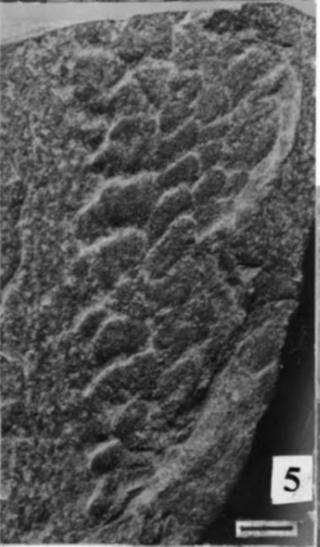
Zolotytsia is an extinct genus of fossil animals from the late Ediacaran period (Vendian) which contains only one known species, Z. biserialis. Specimens of this species have been found in Russia, Ukraine and India.
Bonata is a monotypic, disk-shaped genus of Ediacaran organism that were originally found in the Ediacaran deposits of the White Sea area, Russia. It has been poorly studied because of the lack of fossil specimens found in the region since the 1980's. It contains a single species, Bonata septata.

Pseudorhizostomites howchini is a enigmatic member of the Ediacaran Biota which was originally been thought to have been a jellyfish of some kind. P. howchini is now though to either have been a pseudofossil, a gas escape structure or perhaps the result of a rangeomorph holdfast being pulled by currents or, if any of these possibilities are not true, some other force from the sediments which enclosed the fossil.
Nasepia altae is a species of Ediacaran Erniettomorph which was described in 1973 from the farms of Vrede and Chamis, Namibia. Nasepia has an appearance similar to that of most other Erniettomorphs from Namibia, with it having a leaf-like body with thin ribs and spindle-shaped bodies, however it differentiates itself from other taxa such as Pteridinium and Rangea in the sense that it has smaller petaloids and with the configuration of the ribs being sub-parallel to its axis.

Gehlingia dibrachida is a species of enigmatic Ediacaran organism from South Australia described in 1998. Gehlingia has been described as having many characteristics of petalonamids, although it has been classified as a rather close relative of the Tribrachidium. The overall shape of Gehlingia contradicts this affinity, however, with its shape being a more Bilaterally symmetrical one although the basic structure similar to that of Tribrachidium appears in Gehlingia as separate branches extending into bifurcating minor branches along with "thumb structures" that are apparent in Tribrachidium in the form of side bulges on an axis.
Staurinidia is a genus of Ediacaran soft-bodied organism from the deposits of the Ust'-Pinega formation. It is a monotypic genus and only contains the species Staurinidia crucicula. The genus was first described in 1985 by Russian palaeontologist Mikhail A. Fedonkin. S. crucicula's four-fold symmetry is present as a result of four canals radiating from the middle of a small cavity in the middle of the body. Other forms with four way symmetry, mainly Medusoid forms, from the Ediacaran comprise an essential chunk of the Ediacaran diversity of symmetry; their organisations are similar to, though smaller than, those of a modern-day Scyphozoan Cnidarian.
References
- 1 2 3 Fedonkin, Mikhail A.; Sciences), Mikhail A. (Head Fedonkin, Laboratory of Precambrian Organisms Russian Academy of; Gehling, James G.; Museum), James G. (Senior Curator Gehling, retired 6 27 2019 South Australian; Grey, Kathleen; Narbonne, Guy M.; Vickers-Rich, Patricia; University), Patricia (Director Vickers-Rich, Monash (16 March 2007). The Rise of Animals: Evolution and Diversification of the Kingdom Animalia. JHU Press. ISBN 9780801886799 . Retrieved 27 June 2022– via Google Books.
{{cite book}}: CS1 maint: multiple names: authors list (link) - ↑ Fedonkin, Mikhail A. (16 March 2007). Neues Jahrbuch für Geologie und Paläontologie. E. Schweizerbart'sche Verlagsbuchhandlung. ISBN 9780801886799 . Retrieved 27 June 2022– via Google Books.